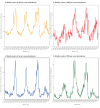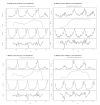Using routine emergency department data for syndromic surveillance of acute respiratory illness, Germany, week 10 2017 until week 10 2021
- PMID: 35801521
- PMCID: PMC9264729
- DOI: 10.2807/1560-7917.ES.2022.27.27.2100865
Using routine emergency department data for syndromic surveillance of acute respiratory illness, Germany, week 10 2017 until week 10 2021
Abstract
BackgroundThe COVID-19 pandemic expanded the need for timely information on acute respiratory illness at population level.AimWe explored the potential of routine emergency department data for syndromic surveillance of acute respiratory illness in Germany.MethodsWe used routine attendance data from emergency departments, which continuously transferred data between week 10 2017 and 10 2021, with ICD-10 codes available for > 75% of attendances. Case definitions for acute respiratory infection (ARI), severe acute respiratory infection (SARI), influenza-like illness (ILI), respiratory syncytial virus infection (RSV) and COVID-19 were based on a combination of ICD-10 codes, and/or chief complaints, sometimes combined with information on hospitalisation and age.ResultsWe included 1,372,958 attendances from eight emergency departments. The number of attendances dropped in March 2020 during the first COVID-19 pandemic wave, increased during summer, and declined again during the resurge of COVID-19 cases in autumn and winter of 2020/21. A pattern of seasonality of respiratory infections could be observed. By using different case definitions (i.e. for ARI, SARI, ILI, RSV) both the annual influenza seasons in the years 2017-2020 and the dynamics of the COVID-19 pandemic in 2020/21 were apparent. The absence of the 2020/21 influenza season was visible, parallel to the resurge of COVID-19 cases. SARI among ARI cases peaked in April-May 2020 (17%) and November 2020-January 2021 (14%).ConclusionSyndromic surveillance using routine emergency department data can potentially be used to monitor the trends, timing, duration, magnitude and severity of illness caused by respiratory viruses, including both influenza viruses and SARS-CoV-2.
Keywords: COVID-19; emergency service; hospital; public health surveillance; respiratory tract infections.
Conflict of interest statement
Figures





Similar articles
-
Establishing severe acute respiratory infection (SARI) surveillance in a sentinel hospital, Ireland, 2021 to 2022.Euro Surveill. 2023 Jun;28(23):2200740. doi: 10.2807/1560-7917.ES.2023.28.23.2200740. Euro Surveill. 2023. PMID: 37289427 Free PMC article.
-
Surveillance of severe acute respiratory infections associated with SARS-CoV-2, influenza virus and RSV using ICD-10 codes: a case definition accuracy study across five European countries, 2021 to 2023.Euro Surveill. 2025 Jul;30(27):2400748. doi: 10.2807/1560-7917.ES.2025.30.27.2400748. Euro Surveill. 2025. PMID: 40642769 Free PMC article.
-
Epidemiology of respiratory syncytial virus in children younger than 5 years in England during the COVID-19 pandemic, measured by laboratory, clinical, and syndromic surveillance: a retrospective observational study.Lancet Infect Dis. 2023 Jan;23(1):56-66. doi: 10.1016/S1473-3099(22)00525-4. Epub 2022 Sep 2. Lancet Infect Dis. 2023. PMID: 36063828 Free PMC article.
-
Characteristics of influenza, SARS-CoV-2, and RSV surveillance systems that utilise ICD-coded data: a systematic review.J Glob Health. 2025 May 23;15:04177. doi: 10.7189/jogh.15.04177. J Glob Health. 2025. PMID: 40406976 Free PMC article.
-
The impact of the 2009 influenza pandemic on the seasonality of human respiratory syncytial virus: A systematic analysis.Influenza Other Respir Viruses. 2021 Nov;15(6):804-812. doi: 10.1111/irv.12884. Epub 2021 Jul 4. Influenza Other Respir Viruses. 2021. PMID: 34219389 Free PMC article.
Cited by
-
Monitoring Public Health Through a Comprehensive Primary Care Database in the Netherlands: Overview of the Nivel Syndromic Surveillance System.JMIR Public Health Surveill. 2025 Mar 12;11:e58767. doi: 10.2196/58767. JMIR Public Health Surveill. 2025. PMID: 40073415 Free PMC article.
-
Monitoring COVID-19 and Influenza: The Added Value of a Severe Acute Respiratory Infection Surveillance System in Portugal.Can J Infect Dis Med Microbiol. 2023 Feb 16;2023:6590011. doi: 10.1155/2023/6590011. eCollection 2023. Can J Infect Dis Med Microbiol. 2023. PMID: 36846348 Free PMC article.
-
[Using emergency department routine data for the surveillance of suicide attempts and psychiatric emergencies].Bundesgesundheitsblatt Gesundheitsforschung Gesundheitsschutz. 2022 Jan;65(1):30-39. doi: 10.1007/s00103-021-03467-x. Epub 2021 Dec 10. Bundesgesundheitsblatt Gesundheitsforschung Gesundheitsschutz. 2022. PMID: 34889967 Free PMC article. German.
-
Establishing severe acute respiratory infection (SARI) surveillance in a sentinel hospital, Ireland, 2021 to 2022.Euro Surveill. 2023 Jun;28(23):2200740. doi: 10.2807/1560-7917.ES.2023.28.23.2200740. Euro Surveill. 2023. PMID: 37289427 Free PMC article.
-
Epidemiological characteristics of respiratory diseases in emergency department patients from different ethnic groups in the Atushi region, Xinjiang.Front Med (Lausanne). 2025 Jun 16;12:1569629. doi: 10.3389/fmed.2025.1569629. eCollection 2025. Front Med (Lausanne). 2025. PMID: 40589966 Free PMC article.
References
-
- Ullrich A, Schranz M, Rexroth U, Hamouda O, Schaade L, Diercke M, et al. Robert Koch’s Infectious Disease Surveillance Group . Impact of the COVID-19 pandemic and associated non-pharmaceutical interventions on other notifiable infectious diseases in Germany: An analysis of national surveillance data during week 1-2016 - week 32-2020. Lancet Reg Health Eur. 2021;6:100103. - PMC - PubMed
-
- World Health Organization (WHO) . Interpreting influenza surveillance data in the context of the COVID-19 pandemic. Wkly Epidemiol Rec. 2020;95(35):409- 15.
-
- European Centre for Disease Prevention and Control (ECDC). COVID-19 surveillance guidance - Transition from COVID-19 emergency surveillance to routine surveillance of respiratory pathogens. Stockholm: ECDC; October 2021. Available from: https://www.ecdc.europa.eu/en/publications-data/covid-19-surveillance-gu...
MeSH terms
LinkOut - more resources
Full Text Sources
Medical
Miscellaneous
